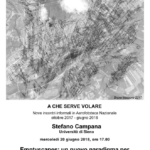Emptyscapes PI made reference, in different occasions, to the analogy between landscape studies and excavation in the shared need for spatial continuity within the area under investigation, in the context of Philip Barker’s 1977 injunction that ‘only total or near-total excavation’ will yield results which are not misleading. Despite appearances there is no conflict between this now widely believed, but frequently compromised, belief and what is going to be suggested in this part of the discussion. However, Barker’s statement of principle should not be treated as a radical belief, not to be altered or qualified in any way. Martin Carver, in 2015, rightly recalled that archaeological excavation requires the removal and permanent dispersal of data and that we should therefore conserve cultural strata as far as possible by not excavating more than was necessary to understand the site or features under investigation. Indeed, Barker himself recognised possible exceptions in specific circumstances, for instance in the case of ‘… stereotyped Roman buildings which may be dug in small areas, the plan then being extrapolated from them with some confidence, but this presupposes that there are no anomalous or unexpected buildings above or below the stereotype …’. The point here lies in the kind of questions that it is reasonable to ask within eithersmall-scale oropen-area excavation.
As a generality it is obviously misleading – and academically hazardous – to suggest or believe that a ‘test’ excavation (still less a ‘shovel test’) can or will reveal the whole sequence of events at any particular location. Targeted excavation needs to be aimed at targeted questions. Within any analytical scale the type and size of area uncovered by excavation must be matched to the purposes that it is intended to serve. Within the research strategy for the kind of landscape research discussed in this book targeted small-scale excavation (as well as targeted field survey or artefact collection) serves a crucial role in providing the chronological and functional feedback that is needed to ‘calibrate’ the integrated interpretation of remote sensing, field-walking survey and geo- and bio-archeological data. Small-scale excavation within the framework of the local analytical scale is essential to provide information about the character and interpretation of particularly important or intersecting elements identified in the first instance through remote As a generality it is obviously misleading – and academically hazardous – to suggest or believe that a ‘test’ excavation (still less a ‘shovel test’) can or will reveal the whole sequence of events at any particular location. Targeted excavation needs to be aimed at targeted questions. Within any analytical scale the type and size of area uncovered by excavation must be matched to the purposes that it is intended to serve. Within the research strategy for the kind of landscape research discussed in this book targeted small-scale excavation (as well as targeted field survey or artefact collection) serves a crucial role in providing the chronological and functional feedback that is needed to ‘calibrate’ the integrated interpretation of remote sensing, field-walking survey and geo- and bio-archeological data. Small-scale excavation within the framework of the local analytical scale is essential to provide information about the character and interpretation of particularly important or intersecting elements identified in the first instance through remote
This kind of small-scale investigation (often misleadingly referred to as ‘ground truthing’) represents the step in the process that aims to verify and either enhance or contradict the initial indications of remote sensing and other survey techniques through comparison with evidence of a different kind. The word ‘truthing’ in this context of course applies to the interpretation, without in any sense implying that the remotely sensed data might be false (Hargrave 2006). If the analysis of remote sensing data is properly executed the probability that identified features have some cultural or paleoenvironmental significance is very high. The need for the archaeologist to ground-check the features seen from the air has been a fundamental concept from the very origins of remote sensing (Poidebard 1927; Crawford & Keiller 1928). This step in the process is essential in order to define the interpretative ‘keys’ and hence to develop or advance the classification of anomalies into useful archaeological categories with differing levels of detail and interpretative precision. In addition, in our case, small-scale excavation is specifically aimed at verifying or critically re-assessing complex data and mutually interacting interpretations of the whole body of evidence recovered from techniques such as aerial survey and geophysical prospection as well as from environmental studies, field-walking survey and a variety of other sources traditionally used in Mediterranean landscape studies. So, within this kind of multidisciplinary perspective, targeted small-scale excavation can and should be expected to explore specific questions, the answers to which can then help in addressing infinitely more complex questions about the historic landscape in a wider sense.
Many contributions to the archaeological literature show that sets of test pits and ‘trial’ trenches have achieved a valid role in addressing particular research questions, distributed over the landscape with a view to obtaining sample assemblages and testing local sequences from which an occupational or behavioural pattern can be generalized. In these cases, however, the interventions are usually placed according to randomly or arbitrarily selected sampling strategies. The rationale adopted in the landscape research of the University of Siena has been quite different, indeed one might say entirely the opposite, targeted at specific locations identified through the integrated interpretation of remotely-sensing data, field-walking survey, artefact collection and so on. Within this kind of framework the excavations assume the character of surgical operations aimed at identifying through minimalist interventions specific stratigraphical evidence about the character and mutual relationships between features and their immediate surroundings. We can perhaps end this chapter, and illustrate the essential role of this approach, by providing evidence from a recent example of targeted excavation in southernTuscany.

